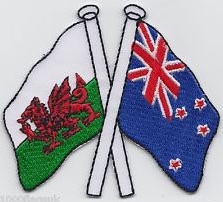 And I haven't even mentioned rugby yet!
And I haven't even mentioned rugby yet! I wasn’t even out of the airport before I involuntarily started to draw comparisons; I felt like I’d come home – to Wales. The two countries reminded me of twins separated at birth. They both have heart-breakingly beautiful, lush, verdant countryside. They both have a lot of sheep. They both have a lot of rain. New Zealand was even part of the colony of New South Wales, until 1841. (New South Wales was named by Captain James Cook, who thought it looked like South Wales in Britain.)
Ok, Wales has fewer vineyards, and fewer volcanoes for that matter, but you don’t have to scratch the surface very far to draw other parallels.
I was born in Wales and it’s therefore very close to my heart. I recognised the hedgerows, the rolling hills, the fecund fields. Even the crash barriers are the same. Ok, some of the plants are a little more tropical than the land of my fathers, and the road signs are different, but reading the signs I faced a similar panic to many an Englishman crossing the Severn estuary heading to Wales – I couldn’t. I found it almost impossible to pick out the syllables that would allow me to start sounding out place names. I wracked my brain for my six-year-old daughter’s reading lessons, but still floundered.
And that leads to the biggest similarity of all. Both New Zealand and Wales are countries dominated by non-natives. The indigenous populations live in harmony or become absorbed. New Zealand is very proud of its Maori heritage. Wales’s original lineage, now dominated by the English, is hidden under so many layers of history, even most Welshmen have forgotten their roots; for this little corner of Britain is not Germanic by descent but Iberian.
Keep digging
I’m sure if I kept digging I would be able to find more similarities between these nations. In fact, quite literally, I bet that if you dug a hole, starting in New Zealand, you would be able to follow the umbilical cord of attachment, through Middle Earth and into Wales. It’s a kind of portal from one place to another. Before you go rushing to your globe to see if this is actually true, I am stretching the truth, although it’s close; if you started digging on the beach on the southern most tip of New Zealand you would end up in the North Atlantic, a little wet, but not too far off the UK coast. Who lets a couple of kilometres get in the way of an interesting theory?!
A photo memory
Either location lends itself to the wink of the camera’s eye, but New Zealand’s sky appears bigger, its waves rougher, its mountains higher. Just add driftwood and stormy purple skies with bubbling clouds to a walk along the beach at Hokikita, and that’s a memory I will cherish through photos.
Sometimes the perfect photo is about turning left instead of right. At Rotorua, I heard fireworks and stepped outside to investigate. I couldn’t see any glittering starbursts, but the sky reflected in the lake was a soft pink that glowed through the clouds. Idly wondering why it was such a brilliant sunset in the east, I turned round to face west to be met with the true meaning of the word brilliant. The east “sunset” was just a reflection of this fiery sky. Within five minutes all evidence had disappeared.
And then there are the picturesque lakeside views that look perfect until the seamless white sky breaks in half, harpooned by snow-capped mountains. Sometimes the best photographs are hidden from view, a secret known only to a few, and revealed only for the shortest of time. I’d love to say my photos of Wales are just as stunning, but these twins have very different personalities.






 RSS Feed
RSS Feed
